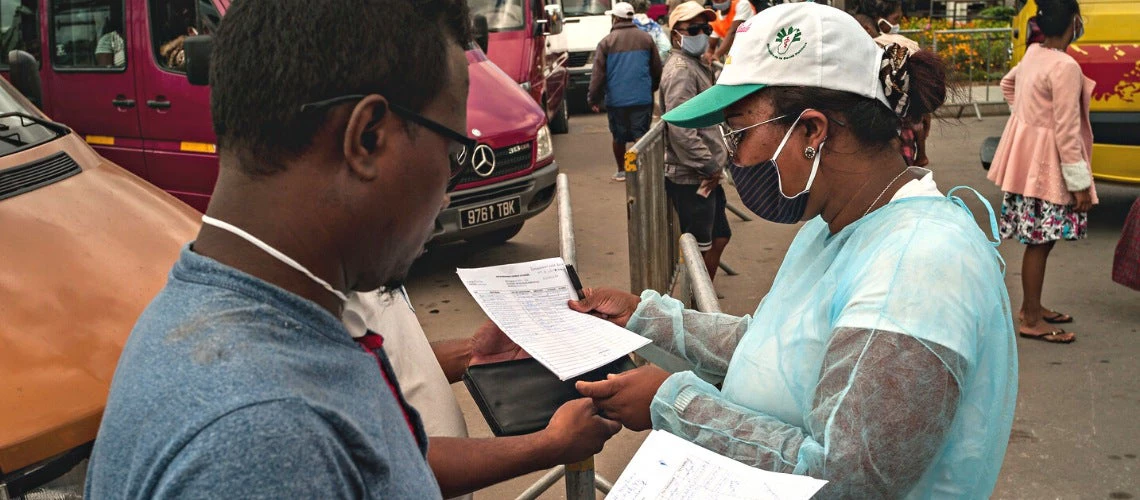 Governments and health organizations have implemented different interventions to reduce the spread of COVID-19, encourage vaccination, and address misinformation, with varying degrees of success. Photo: World Bank/Henitsoa Rafalia
Governments and health organizations have implemented different interventions to reduce the spread of COVID-19, encourage vaccination, and address misinformation, with varying degrees of success. Photo: World Bank/Henitsoa Rafalia
Since the first COVID-19 cases were reported, over 620 million people have been infected and 6.5 million people have died of the disease as of October 2022. While it is difficult to predict the end of the pandemic, experts are already predicting the next one .
Governments and health organizations around the world have implemented different interventions to reduce the COVID-19 spread, encourage vaccination, as well as address misinformation and “fake news” with varying degrees of success. As the largest funder of the global COVID-19 pandemic response, the World Bank has committed $14 billion to over 100 countries. This financing has helped countries expand access to testing for early detection and response, buy and distribute vaccines, and engage with citizens and communities to address vaccine hesitancy, among other activities.
As a part of its COVID-19 pandemic response, the World Bank has analyzed the results of different activities in a new policy brief Behavioral Science and COVID-19: An Interactive Solutions Guide for Better Policy Design .
Here are a few lessons learned on what has worked:
Reducing the spread of COVID-19
Many governments banned gatherings, closed businesses and schools, and enforced social distancing and mandatory mask-wearing. These measures were mostly adopted early in the pandemic but have been relaxed in recent months.
Evidence shows that restricting social contacts has generally yielded positive outcomes, but success varied depending on the country. Restrictions were more effective when implemented early .
Restricting gatherings and closing schools and businesses greatly helped mitigate COVID-19 spread. However, such stringent restrictions incurred significant societal and financial costs—including learning loss, learning inequality , drops in business sales , and a substantial impact on mental health.
Mask-wearing and social distancing also contributed to reductions in COVID-19 spread, but epidemiological evidence suggests that these less disruptive measures also had weaker impacts compared to stricter regulations. When making decisions, policymakers need to consider the impacts and costs of these different measures.
Figure 1: How to reduce the COVID-19 spread
Download our publication here to learn more.
Encouraging people to get vaccinated
Vaccination has been another critical component in taming the pandemic. We have learned that governments can encourage vaccination in many ways, such as:
Provide incentives. In general, incentives increased the number of people being vaccinated. In some countries, non-financial incentives, such as food items , were also effective. While incentives need to be large enough to attract people, when too large, they can make people suspicious about the vaccine risks and result in lower vaccination . Also, lottery programs providing cash prizes for the vaccination slightly increased vaccine uptakes at least in the United States.
Communicate vaccination effectively. Generally, sending multiple reminders helps increase vaccination. In addition, using social norms messages (e.g., “Many in your country already have been vaccinated. Join them.”), the right messenger (e.g., healthcare professionals of the same race as the target group), and effective messages can increase vaccination.
Make access easier. Create an easy vaccination appointment scheduling system and automate appointments. Governments can also mobilize vaccination sites into the community and expand immunization coverage with increased hours and locations.
Make it harder to remain unvaccinated by making vaccination appointments default, introducing a mandatory vaccine certificate (vaccine pass) , and imposing a fine or disadvantage for not getting vaccinated. Generally, these measures have worked well. However, overly-regulatory measures can limit people’s access, freedom, and basic human rights.
Figure 2: Daily new vaccinations by age group in France, Israel, Italy, and Switzerland after the introduction of a mandatory COVID-19 certificate
Addressing misinformation and fake news
As the first pandemic in the social media era, we are experiencing the infodemic with rampant misinformation and fake news . People can share misinformation without realizing it, and such misinformation can lead to vaccine hesitancy.
To address COVID-19 misinformation, governments can teach common misinformation techniques (pre-bunk) using infographics, video clips , and games. They can also use fact-checkers to directly address specific misinformation (de-bunk). Lastly, some social media channels use reminders to ask people to check the accuracy of information before sharing.
Research shows that teaching misinformation techniques and using fact-checkers were effective although their impact was limited . Using gamification to teach misinformation techniques helped people identify misinformation, and promoted users sharing the intervention with others. Currently, we are testing the effectiveness of this approach in low- and middle-income countries with a new a chatbot-based game that users can play to learn about common misinformation characteristics.
Preparing for the next pandemic together
There is no one single silver bullet to prepare for the next pandemic. Akin to the phrase “building the plane while flying it,” many of the COVID-19 pandemic responses were ad hoc. Still, as we continue to learn from responses to COVID-19 and other infectious diseases, we will better understand effective interventions tailored to the unique set of problems and contexts.
Want to learn more? Download our Behavioral Science and COVID-19: An Interactive Solutions Guide for Better Policy Design .
Did we miss anything? Do you want to collaborate? We want to hear about the problems that you are trying to solve. Visit our website to stay connected and reach out to us.
The work, led by the Mind, Behavior, and Development (eMBeD) unit of the Poverty and Equity Global Practice (GP), the Health, Nutrition and Population GP, and the Development Impact Evaluation Department (DIME) is supported in part by the Alliance for Advancing Health Online (AAHO), an initiative to advance public understanding of how social media and behavioral sciences can be leveraged to improve the health of communities around the world.






Join the Conversation